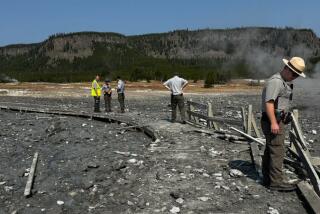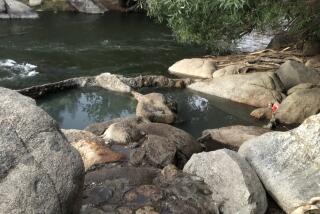Monumental Loss in Yellowstone
- Share via
YELLOWSTONE NATIONAL PARK, Wyo. — Swirling steam turned Roderick “Rick” Hutchinson into an apparition as he paddled across the continent’s largest near-boiling hot spring in an extraordinarily stable and well-insulated rowboat designed for the purpose.
“Steady now,” he said, leaning toward a port in the bottom of the boat and lowering instruments to gauge depths never measured before. The opening became a placid window into Grand Prismatic Spring’s turquoise interior, filled with pearly mineral formations that resembled the clouds in the sky.
Before his death in a wilderness avalanche earlier this year, Hutchinson had brought modern science to Yellowstone, using it to expose the very heart of the bubbling and boiling national park, colleagues said.
As Yellowstone’s research geologist for almost 30 years, he was the only scientist dedicated solely to tracking the activity of Yellowstone’s more than 300 geysers and myriad hot springs, monitoring them like biologists do grizzly bears. Through the geysers’ behavior, he began to unravel their plumbing, in the process becoming one of the few people to ever forecast an earthquake, and collaborated with astronomers who saw the world’s best-known geyser as a model of volcanoes on other planets.
His death will leave research on the otherworldly geology of the fantastic national park foundering, fellow researchers say.
“It’s a tremendous loss both for Yellowstone and for science,” said James Westphal, a professor of planetary science at Caltech and a lead scientist for the Hubble Space Telescope. “Yellowstone tells us lots about the Earth and Rick knew it better than anybody.”
Hutchinson, 49, and visiting geologist Diane Dustman, 37, of Boston were killed while mapping geysers and hot springs near Heart Lake, eight miles from the nearest road. They were apparently traveling on cross-country skis when an avalanche swept down Factory Hill (so-called because of its steam vents) and engulfed them.
Searchers found their bodies under several feet of snow a few days later.
Fellow researchers knew Hutchinson as a quiet but witty geologist as eager to share Yellowstone’s secrets with tourists as with scientists. His encyclopedic knowledge of the volcanic wonderland that is home to two-thirds or more of the world’s known geysers allowed others to use it, in turn, as a window on the inner Earth.
“He was really a singular voice within the National Park Service to try to understand these phenomena,” said Paul Silver, a geophysicist at the Carnegie Institution of Washington, D.C. “Without a lot of support within the government, he accomplished some tremendous research that’s invaluable to our knowledge of geology.”
After installing an infrared monitor to record Old Faithful’s eruptions, Hutchinson noticed in the early winter of 1990 its pace quickening by an average of four minutes between eruptions, the sort of variation that had preceded past earthquakes. Sensing that subterranean forces were squeezing the geyser’s plumbing, he predicted without much fanfare that a tremor could be on its way. Just before Christmas of that year, a 3.8 earthquake struck the park’s western boundary.
He, Silver and others last year had begun electronic tracking of other geysers to identify even more precise harbingers of earthquakes amid Yellowstone’s ancient but restless volcanic caldera. The work was to build on Silver’s earlier study of geysers in California. It will continue, Silver said, but minus its most hands-on collaborator.
“A lot of what we were doing was really checking out hunches he had,” Silver said. “Ultimately, he was the one who made it work.”
Hutchinson came to Yellowstone in 1970 to lead walks through the geyser basins. He received his master’s degree in earth science at Iowa State University in 1974 and stepped into a permanent job as the park’s research geologist. His wife, Jennifer Whipple, is a park botanist.
Hutchinson overcame his remote location and lean government budgets. Although he could not afford expensive infrared detectors for geysers other than Old Faithful, he purchased cheaper devices designed to keep track of temperatures in refrigerated produce trucks.
By deploying the coffee can-size monitors in the runoff channels of geysers, Hutchinson collected computerized records of temperature changes that marked geyser eruptions. His results revealed connections between geysers and springs nobody had noticed before.
“In all my years, he was the one person I’ve known who is truly irreplaceable,” said Yellowstone research chief John Varley. “He cherished his job. His idea of going on vacation was going to work.”
*
When Caltech’s Westphal and colleague Susan Kieffer were trying to figure out the workings of volcanoes on Earth and, in particular, on other planets, they eyed Old Faithful as a model. Working with Hutchinson, they lowered an armored and insulated video camera down the geyser’s throat between eruptions, finding an underworld of subterranean passageways and chambers battered with boiling waves as ferocious as the ocean surf.
“He had an intuition about how that might work,” Westphal said. “His specifics might have been off, but in general, he predicted exactly what we found--that the geyser’s system is more complicated than we can understand or ever will understand.
“Rick was really an old-fashioned explorer in a way that wasn’t obvious.”
Sound science, Hutchinson believed, was the best armor with which to defend Yellowstone against the kind of geothermal drilling that has dried up many of the world’s other geyser fields.
Wilderness forays kept him in touch with phenomena that tourists seldom see. He charted the birth of a superheated fumarole by strapping a high-temperature thermometer to a tree limb and bracing it over the blasting vent with both hands.
As Hutchinson watched in 1995, the fumarole metamorphosed into a mud volcano that shook the earth, threw out bombs of clay and sucked full-grown pine trees down like swizzle sticks. He cited it as evidence that the Yellowstone landscape, as much as the bears, elk and buffalo that inhabit it, lives and breathes in its own rhythm.
*
It continues to fulfill that promise. Only since last summer, Giant Geyser has broken 40 years of near dormancy, erupting 10 times to twice the height of Old Faithful.
With a network of seismographs and other instruments laid out under Hutchinson’s guidance, Robert Smith, a University of Utah professor of geophysics, recently found that the earthquake-prone Yellowstone caldera is falling 1.5 centimeters a year, a brisk pace by geological standards. The decline, reversing decades of uplift, probably betrays the migration of underground fluid, whether molten rock or the scalding waters that power the geysers Hutchinson knew so well.
“Rick had an incredible understanding of the geothermal systems that comes only from years of observations and study,” Smith said. “I don’t know how we’re going to keep track of everything without him. I really don’t.”
(BEGIN TEXT OF INFOBOX / INFOGRAPHIC)
1. Site if avalanche that killed Yellowstone geologist Roderick “Rick” Hutchinson and visiting geologist Diane Dustman.
2. Old Faithful geyser
3. Grand Prismatic Spring, a large, near-boiling spring that Hutchinson had gauged from a specially insulated boat
4. Superheated fumarole tht appeared in the park back country and then grew into a vat of roiling mud called a mud volcano.






